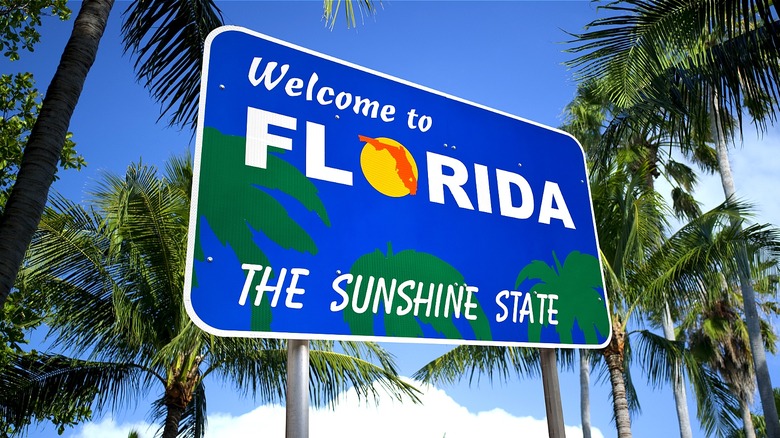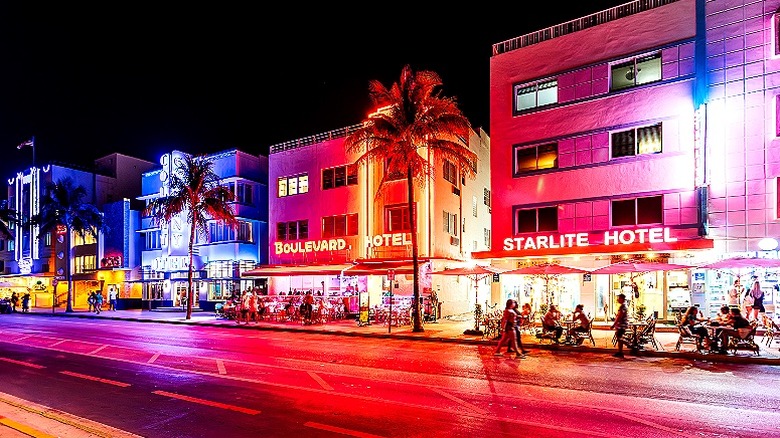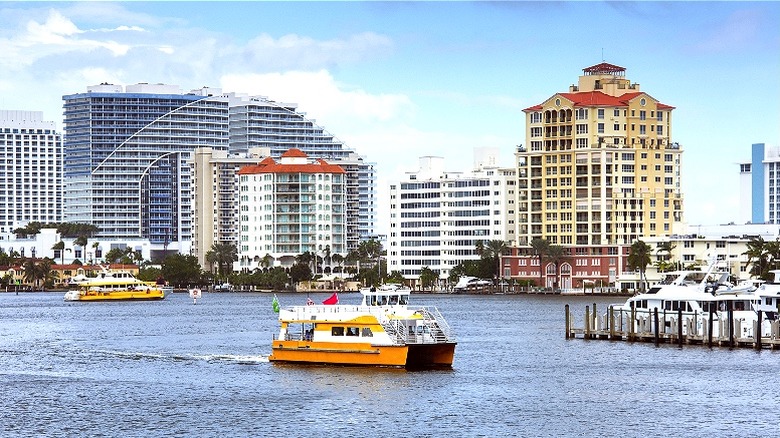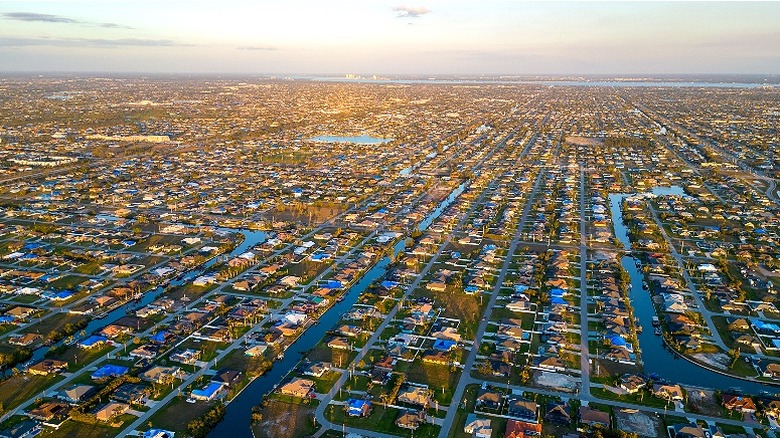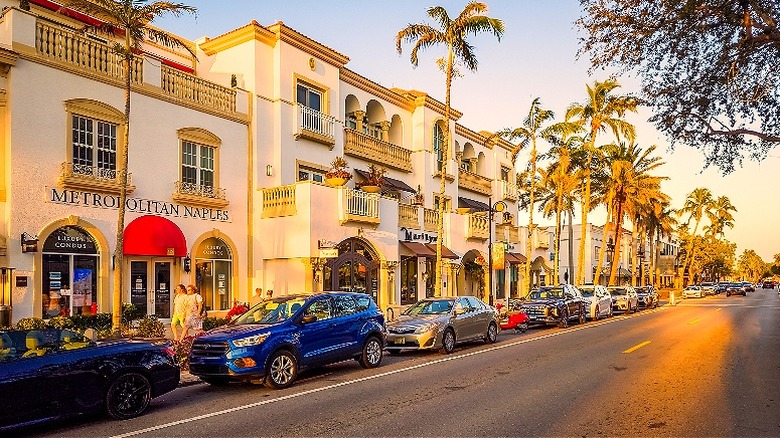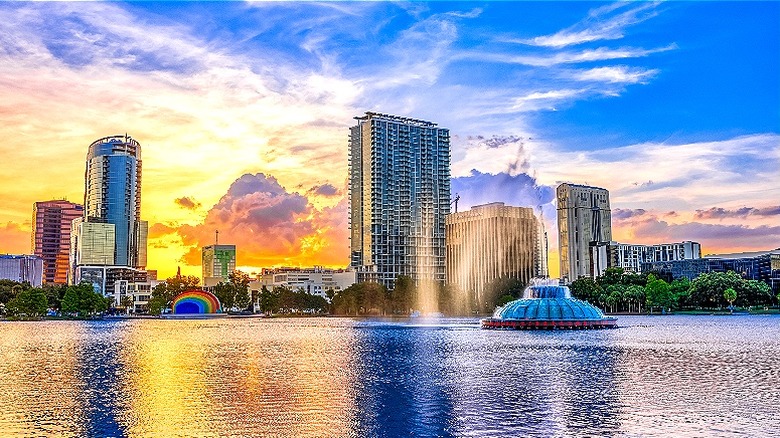You've Been Warned: Buying A House In These Florida Cities Will Cost You
Among the many states known for warm weather and sunny skies, perhaps none are as popular for retirees as Florida. In fact, according to U.S. Census Bureau data, 21.1% of the population of Florida was between 65 and 84 in 2020 (with 2.5% over the age of 85). The most recent Florida State Plan on Aging predicts that, by 2045, the older adult population in the state will increase to 8.4 million (which would be over 30% of the state's entire population). While there's no denying the popularity of Florida's beautiful beaches and warmer climate, there are serious downsides to consider as well. Specifically, as climate change-fueled weather events continue with increasing frequency, Florida could end up being a bad financial investment (and, ultimately, one of the places you should avoid buying a home in).
We spoke to Dutch Mendenhall, investor and author, about some of the challenges that can come with buying and owning a home in Florida today. "When buying a home in Florida, it's essential to focus on climate resilience," he said. "Here's the deal: Properties in this state are increasingly at risk from flooding, hurricanes, and rising sea levels. So, before you dive into purchasing, you need to dig into the insurance costs — they can be sky-high in high-risk areas." Among steeper prices for car and homeowners insurance than other states, would-be buyers could also run into increased difficulty when it comes to actually finding an insurance provider at all. This said, let's break down the top Florida cities you should steer clear of when house-hunting.
Miami
Known for its beautiful views, unique culture, and nightlife, Miami can be an exciting option when house hunting. Plus, according to May 2024 home price data from CoreLogic, Miami had the highest home price value gain (at 10.6% year over year) out of 10 large metro areas across the country. The city's strong property values could make the growth potential of a home purchase especially alluring. However, as Dutch Mendenhall explained to us, "Miami's low elevation and coastal location make it extremely vulnerable to sea-level rise and flooding." On that note, Moody's Analytics determined that Florida faces the greatest acute physical risk threat in the country, in large part due to the state's high risk of hurricanes.
If you're wondering what all this means for you as a homeowner in Miami, Mendenhall explained the reality. "Homeowners insurance costs are steep, reflecting the climate risk. With a median home price of $670,000 and notable foreclosure activity, it's crucial to weigh these factors," he said, adding, "The city's susceptibility to floods and hurricanes could impact property values and insurance costs down the line."
According to Florida insurer Oyer, Macoviak and Associates, Miami homeowners had an average homeowners insurance premium of $16,717 in 2023. Another important consideration when it comes to what your day-to-day activities might look like in Miami is traffic. Mendenhall noted, "Miami's traffic congestion can be quite a headache, especially during rush hour," which can prove especially difficult to navigate when you consider just how much 9-to-5 traffic patterns have changed in the U.S. since the pandemic.
Fort Lauderdale
Another popular option in Florida is Fort Lauderdale. Located north of Miami on the southeastern coast of the state, the city offers many of the same beautiful beaches and scenic views as Miami does, with a quieter, less nightlife-focused city atmosphere. However, much like Miami, Fort Lauderdale faces increased risk from climate change. As Dutch Mendenhall told us, "Fort Lauderdale is at risk from flooding, with a history of severe weather events and rising insurance premiums." Further, it's important to keep in mind that homeowners insurance is one of the top things insurance companies don't want to cover anymore, so you could find yourself struggling to find a provider, let alone an affordable one.
Another thing to consider about Fort Lauderdale is how the region's housing market might inflate properties. "Home prices are climbing, which might lead to overvaluation" Mendenhall explained, before adding, "With a median home price of $627,500 and increasing foreclosure rates, buyers must balance potential future property damage and higher insurance costs against the benefits of buying here. Climate change could further affect property values and insurance premiums."
Increases in both property taxes and insurance premiums, combined with the financial strain of inflation, have been significant enough to lead to a rise in foreclosures across Florida. According to a real estate report from ATTOM, Florida had the third-highest number of foreclosure filings in the U.S. during the first half of 2024.
Cape Coral
Dutch Mendenhall explained the appeal of Cape Coral, "Cape Coral is celebrated for its abundant waterways and is a popular destination for outdoor enthusiasts, offering numerous boating, fishing, and wildlife viewing opportunities." While smaller than its more popular neighbors (Cape Coral is the eighth-largest city in Florida by population), the city is only currently about 60% built out, which offers the unique opportunity to build your own custom home or purchase a new build. However, as Mendenhall pointed out, "Cape Coral offers tempting waterfront properties but is also vulnerable to hurricanes." This is especially true when you consider that Cape Coral's location, on the western coast of Florida, is one of the most susceptible to hurricanes.
And, with the increased risk of hurricanes comes a long list of concerns for potential homeowners considering Cape Coral. According to Mendenhall, "Insurance costs can be high, and the city's canal system pressures its infrastructure, complicating flood management." The city boasts over 400 miles worth of scenic canals, which can be a beautiful addition to a neighborhood but also a significant problem when it comes to hurricanes.
Said Mendenhall, "With 5,701 homes sold last year and a median price of $380,000, plus 37.53% of homes being equity-rich, be aware of the extra expenses and the risk of property value decline due to climate issues." Moody's Analytics also found that Cape Coral was one of the top metro areas facing the highest levels of chronic physical risk with rising sea-levels and water stress being major factors.
Naples
Located south of Cape Coral on Florida's western coast, Naples is one of the state's most expensive cities to live in. In fact, one neighborhood in particular, Port Royal, ranked second in Bloomberg's list of priciest neighborhoods in the U.S. (with the top spot going to Miami suburb Coral Gables).
Despite this, Dutch Mendenhall explained that "Naples is a desirable spot with a strong real estate market, but it's not without its climate risks. Hurricanes and flooding are concerns, and the cost of living, including insurance, is higher." While you might be thinking that a slightly higher insurance premium could be a manageable expense, it's important to realize that Florida homeowners pay more than four times the national average for home insurance, with the average cost increasing more than 40% since 2023. Even worse, these premiums are only going to increase as climate change-related weather events continue to happen with more frequency.
Added Mendenhall, "Last year, the city recorded 10,836 residential sales with a median price of $630,000, and 39.84% of homes were equity-rich. While Naples has solid property values, increased environmental risks or economic downturns might challenge significant appreciation." In addition, he offered insight into another important consideration for anyone looking to buy in the city, saying that "Naples can be relatively quiet and lacking in nightlife, which might not suit everyone's taste." That said, the higher quality of life and generally upscale setting could serve as an attractive investment opportunity for those willing and able to spend significantly more on insurance and costs.
Orlando
Perhaps best known for attractions like Disney World, Orlando can seemingly offer more relative safety for homeowners given its inland (i.e., non-coastal) location. Plus, as Dutch Mendenhall said, "Orlando's status as a major entertainment hub and its expanding economy offer strong investment opportunities with promising returns." However, despite the positive possibilities, Mendenhall added, "Orlando still faces climate risks like flooding and severe weather." While the chances of flood and storm surges are less likely in Orlando compared to its coastal neighbors, there's still an increased risk of hurricanes and tropical storms, both of which can bring destructive winds to the city.
Mendenhall broke down the current housing market in Orlando. "Over the past year, Orlando saw 10,975 home sales with a median price of $437,500, and 47.05% of homes are equity-rich," he said. However, despite the supposedly safer environment of Orlando, he explained, "Property costs are on the rise, and while they're currently lower than in some other Florida cities, future climate impacts could drive up maintenance costs and insurance premiums."
Mendenhall told us that potential homebuyers should keep a close eye on not just potential future costs but also the possibility of decreased property values as a result of climate risks. Similarly, living in a high-tourism area could lead to increased frustrations with everything from heavy traffic (which is exacerbated by Orlando's lack of public transportation) to increased wait times and crowding at restaurants, events, and in public areas.
